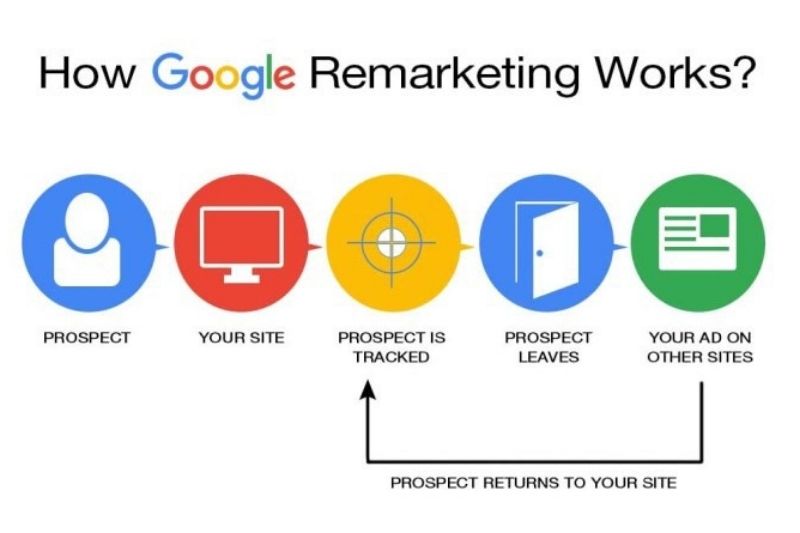Google remarketing, also known as retargeting, is a valuable advertising tool to help you identify and target potential customers, increase your engagement levels, and drive sales.
Google remarketing can drastically improve your business’ conversion rates, and it’s very easy to implement. Remarketing, also known as retargeting, refers to a method of online targeted advertising, where businesses are able to show targeted ads to users who have already visited their website. Past site visitors will be able to see these ads while they are doing all sorts of actions on the Internet, such as checking social media, watching YouTube videos, or browsing the latest news headlines. This allows you to keep your brand top-of-mind for potential customers, and/or can remind potential customers to finish an uncompleted action on your website.
How Does Google Remarketing Work?
If you’ve followed our previous guide on creating your own Google Ad, the next step is adding a piece of Google’s remarketing code (also known as a tag or pixel) to your website. The code allows your website to track different visitors visiting the page and add them to remarketing audiences through the use of browser cookies.
Google also gives users the capability to customise the code for certain pages on your website in order to make your ads more specific and target more defined audiences.

For example, let’s say you operate an online shop that sells kitchen supplies. You can create a “utensils” remarketing audience based on the people who either visit the pages of your site where you sell utensils, or search for utensils in the search bar. This way, you can identify the visitors who are potentially interested in purchasing utensils from your shop, and show them targeted ads that can help them come to a final decision. If they’ve left your site without making a purchase, you can also use Google Remarketing to lure them back in with offers such as “free shipping” or “10% off next purchase”.
With remarketing, you can also show targeted Google ads to your previous site visitors whenever they visit sites on the Google Display Network (such as Google and Youtube), as previously explained in our Google Ads article.
When you are experimenting with remarketing for the first time, you should start by targeting everyone who has simply viewed your homepage to get a sense of how the remarketing process actually works.
Once you’re familiar with the process of remarketing, you can begin narrowing your targeting to more specific audiences. Google Remarketing also offers many customisation options when it comes to deciding the demographic of users you want to target. For example, you can choose to show users who have already purchased from your site different ads compared to those who clicked on your site and left (such as offering former customers 10% off their second purchase).

Selecting Your Target Audiences
Similar to Google Ads, the very first step to remarketing is to analyse your data and develop a strategy that you can use to identify your target audience. Luckily, Google Remarketing offers a plethora of options for deciding who to target and how to target them. Here are some of the filters you can use to sort through potential target audiences:
• Based on the product page visited (utensils/pans/containers)
• Based on visiting a certain page of your checkout process
• Based on not visiting a certain page (like a “thank you for making this purchase” page)
• Time spent on website
• Number of pages visited
• Targeting by demographic (age, etc.)
• Geographic targeting
The benefit of having this many filters is that you can be very specific with how you narrow down your specific target audience, as you can use them in combinations with one another. For example, if you wanted to target potential customers who added products to their cart, but didn’t end up making a purchase, you could filter users by the “based on visiting a certain page” as well as “based on not visiting a certain page” options, and find people who visited the first page of your checkout process without hitting the thank you page.

Why Should You Use Google Remarketing?
Google remarketing is one of the most powerful online marketing tools out there, because it enables you to stay in touch with your target audience even after they navigate away from your site. By continuously displaying your business’ banner ads to visitors and potential customers even as they browse other websites, you are already gaining a lot in terms of brand exposure. Once your target audience recognises your company more as a result of continuously seeing your ads, their trust will be raised, and they will be more likely to purchase from you.
Google remarketing ads have much higher click-through rates and conversion rates than typical display ads. Once you have established a connection with a potential customer, they will be much more willing to buy one of your products. According to WordStream, previous site visitors will click on your ads at double, and sometimes even triple the rate of new visitors.
Additionally, Google remarketing ads are very cost-effective when compared to other ad campaigns available to businesses. Indeed, displaying ads in super-competitive industries can cost several dollars or more per click, whereas Google remarketing ad clicks across many industries cost less than a dollar per click.
To fully utilise Google remarketing’s cost-effectiveness, use Google remarketing in tandem with contextual targeting (only targeting customers who aim to buy a specific product), Google Ads (Google’s affordable ad service), and other cost-saving strategies. Once you are able to narrow your target audience down, you will be able to create highly targeted remarketing campaigns and increase your ad relevance, which means the majority of your ads will be displayed to the potential customers who are most likely to click on your ad and end up making a purchase.
Wrapping Up
Google remarketing might not work for everyone, but it’s important that you keep your remarketing ads brand-focused, as people tend to pay more attention to ads from companies that they’re already familiar with, compared to an ad from a company they’ve never heard of before.
If you include a special deal or discount in your remarketing ad, you need to make the initial landing page reflect the deal that was offered. If a potential customer clicks on an ad offering a deal and doesn’t immediately see any indicators that the deal is actually there, they’ll be more inclined to just leave your site.
Google remarketing is a powerful targeting method that companies should aim to utilise to increase their conversion rates and lower their advertising costs. Many companies will see huge and immediate returns just by tailoring ads to go after the specific target audiences that they’ve narrowed down. So what’s stopping you?
Related Articles
Google Ads: How to Grow Your Business by Using Ads Effectively





